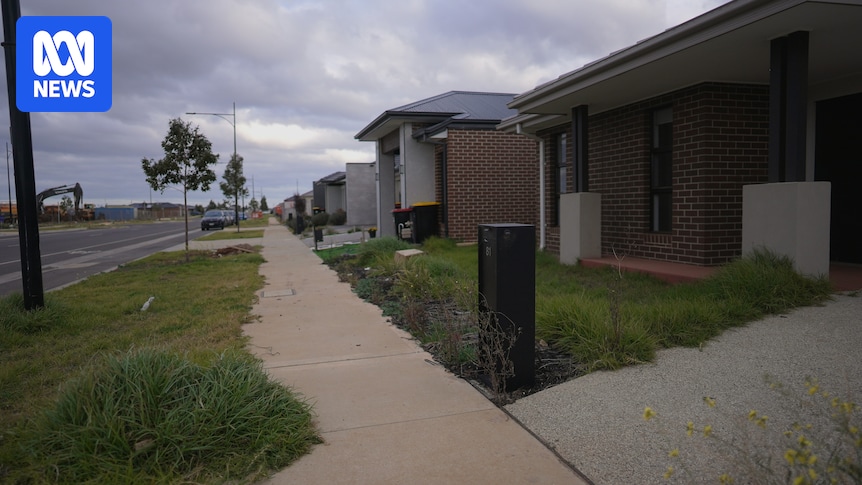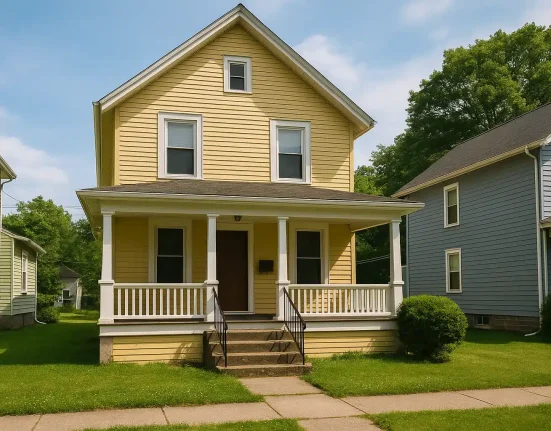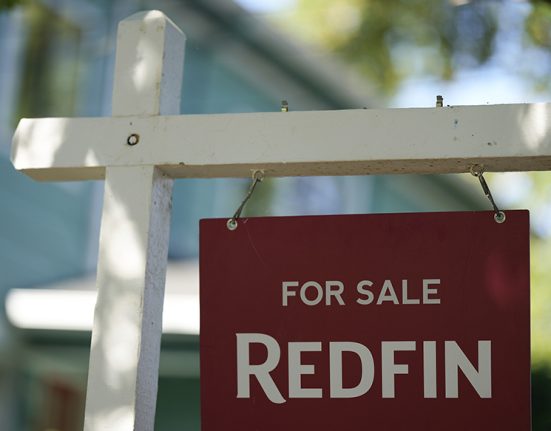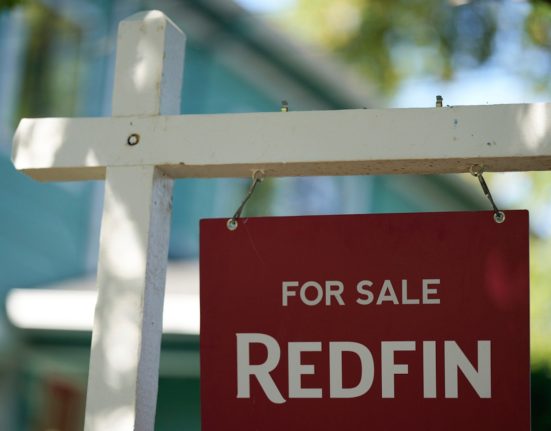At first glance, driving through the new estates on Melbourne’s western fringe, the houses look ordinary.
Single-storey, brick veneer frontages, finished in a grey monochrome.
But look closer and the differences are clear: step-free entrances, extra-wide doorways, and bathrooms designed for wheelchairs.
These homes were purpose-built for people with profound disabilities.
Dozens of these buildings are scattered through these neighbourhoods, part of a federal government scheme designed to get people with a disability out of group homes.
But Four Corners can reveal that more than 1,000 of these properties sit vacant around the country, jeopardising significant private investment.
There are hundreds of brand new, purpose-built homes across the country without tenants. (Four Corners: Rob Hill)
‘A good investment’ turned sour
Like thousands of people around Australia, Tony Wilson and his wife were drawn to Specialist Disability Accommodation (SDA) when they were looking for somewhere to invest.
The NSW Central Coast couple got in touch with a financial advisor, who told them there was “high demand” and strong returns for these properties.
“It sounded like a good investment to us, an ethical investment, which was something we were interested in, the idea of providing a property to someone in need,” Tony told Four Corners.
Tony Wilson invested in two SDA properties. (Four Corners: Rob Hill)
The idea behind the investment is indeed legitimate.
In 2016, the federal government created SDA to get people with profound disability out of institutions like group homes and aged care facilities.
Under the scheme, the government asked private investors to build smaller-scale, customised houses.
In return, the government would pay investors up to around $110,000 per year for each eligible person who moved in.
Tony Wilson and his wife spent almost $2 million building two disability houses — one in Melbourne’s outer suburbs and one in Perth — expecting to see rental returns of more than $150,000 per year.
But there was a problem. Despite their financial advisor’s optimism, no one wanted to move in.
The Wilsons turned to multiple disability providers and consultants to fill the houses, but more than a year later, they still haven’t found any SDA-eligible tenants.
To fund the SDA houses, they borrowed against their family home and spent a large part of their superannuation. They are now struggling to keep up with mortgage repayments without the advertised six-figure rental income.
Mr Wilson said they were skipping meals and medication to help make ends meet.
“My wife’s had to go back to work after a long period where she’s been at home looking after elderly and unwell parents … but we’re still not making it,” he said.
“We’ve both had breakdowns as a result of it.
“We were looking at [retiring] five years down the track … now, I can’t see us retiring at all. We won’t have enough money to retire on. That’s the bottom line.“
The Wilsons were told that there was “high demand” for SDA homes. (Four Corners: Ryan Sheridan)
If they sell their SDA houses, they will lose hundreds of thousands of dollars on what they paid because there is now a glut of disability houses in the areas.
The Wilsons think they have no choice but to sell their family home to pay back what they have borrowed.
“We’ve still got kids at home,” Mr Wilson said.
“It’s a nice place to retire … would have been, but doesn’t look like that’s going to be the case.”
Location frustration
There are investors like the Wilsons all over Australia, who have built or bought disability homes where they are not needed, often under the guidance of property or investment advisors.
Property investment advisor Goro Gupta said part of the problem was that the NDIA — the agency that administers the policy — has not released clear data about where eligible people with a disability want to live.
That has meant many SDA houses have been constructed on the outskirts of capital and regional cities where the land is cheap.
“That’s why, of course, the average investor wants to invest,” Mr Gupta said.
“But it’s not necessarily where people with disabilities want to live.“
Goro Gupta says SDA properties have been built in areas that don’t suit people eligible for the scheme. (Four Corners)
At one estate in outer western Melbourne, he was incredulous that so many houses for people with profound disabilities have been built.
“In these areas, there’s a lack of amenities,” he said.
“It’s not close to shops, it’s not close to the allied health services that people with disabilities need on a day-to-day basis.
“I mean, have a look at this area. It’s paddocks!”
For some investors who have overextended to build the homes, renting them out as a normal property isn’t an option, because the returns are nowhere near enough to cover their mortgage repayments.
That means the homes are sitting empty in the hope that an eligible disability client will move in.
The true scale of oversupply
The agency in charge of administering disability housing does not have a clear picture of how many homes are unoccupied.
Four Corners has found that some streets in Melbourne’s outer west have more than half a dozen houses that are empty. And in one location, there were more than 10.
There are 11 empty SDA homes on this street in outer Melbourne alone. (Four Corners)
The ABC’s analysis of the little data available showed that across Australia, there were at least 760 vacant SDA properties, out of 7,500 that have been built.
But the peak body that represents almost half of the SDA market in Australia told Four Corners that the number of empty homes would likely be significantly greater.
“I would argue that there’s well in excess of a thousand empty homes across Australia at the moment,” said Jeramy Hope, the CEO of SDA Alliance.
Jeramy Hope believes there are more than 1,000 empty SDA homes. (Four Corners: Ron Foley)
That means close to 15 per cent of disability housing built in Australia, at the cost of hundreds of millions of dollars, is not being used for its intended purpose.
There is now a glut of vacancies in cities around Australia, including Melbourne, Adelaide, Brisbane, Sydney, Townsville and Toowoomba.
And the oversupply could get even worse.
NDIA data showed there were more than 800 disability houses under construction in Melbourne’s west, where there were already dozens of empty homes.
“The intent of SDA was … that there was meant to be some maturity of the investors, the builders, the providers to have those conversations with participants and support providers around where people wanted to live,” Mr Hope said.
“We can clearly see in the data that that didn’t occur.“
More SDA homes are being built in Melbourne’s outer west despite hundreds of vacant properties in the area. (Four Corners)
Embracing independence
Bruce Camplin can not bear to think about what life would have been like for him if he had not moved into his Specialist Disability Accommodation apartment.
Far from living in the outer suburbs, Bruce is right in the heart of the Gold Coast, living proof of the scheme working as it should.
“I’m so grateful for the opportunity … I’ve embraced it and it’s only been a positive for me,”
he said.
Bruce has arthrogryposis, a joint and muscle disability, which means he can’t bend his knees or elbows.
Living in an SDA apartment has been life-changing for Bruce Camplin. (Four Corners: Jessica Longbottom)
Before he moved into SDA, he had been living in institutions his entire life.
“It was no privacy … to having no real sense of independence,” he recalled.
“I thought that what I had for 50 years was the best that I was going to have.”
He has now embraced making his apartment his own, covering every available space with homely touches like beach knick-knacks, a whisky decanter, and spice racks.
His apartment is complete with automatic doors, blinds and lights, a customised bathroom and benches at wheelchair height. He now needs less time with support workers as a result.
“It can make people more independent and social and give them a sense of dignity and everything that goes with having your own home,” he said.
More than ever, he now feels part of the community, and has friends all over his apartment block and at the local surf club, where he has begun swimming.
“I have met more people in the two years and two months that I’ve been living here than I did in the 34 years at the group home.“
Bruce Camplin is living proof of the SDA scheme working as it should. (Four Corners: Rob Hill)
While it has been life-changing for Bruce, the goal of getting people out of group homes en masse appears to have failed.
There is no accurate data, but disability advocates say the number of those in group homes is around 17,000 people, which is roughly the same as when the SDA policy was introduced.
There has been progress with getting young people with a disability out of aged care, with enrolments decreasing from around 5,500 people in 2018 to 960 people this year.
Risk of a ‘squandered’ opportunity
Disability housing consultant Brent Woolgar described what has happened in SDA as “market failure” that came about from a lack of regulation.
He was concerned that because so many investors have been burnt, investment in new houses will dry up, and houses won’t be built where they are actually needed.
“I just have this real sense that we’re really getting to a point where we have potentially squandered a once-in-a-generation, potentially multiple-generation opportunity, to provide amazing housing outcomes for people with disability,” he said.
“That’s really, really sad.“
Brent Woolgar believes the SDA scheme is “market failure” in action. (Four Corners)
He said a key problem was that the NDIA — which has been set up to help people with a disability — has been asked to manage a mass housing rollout.
“I do think there was a potential huge missed opportunity for the community housing sector to get more engaged, and I think we would’ve had a much more successful outcome,” Mr Woolgar said.
In a statement, the NDIA said it was “a market steward” of the scheme.
“The NDIA is committed to supporting a robust and efficient market for Specialist Disability Accommodation that gives NDIS participants the modern options and choices that they deserve,” a spokesperson said.
“SDA investors should always conduct their own thorough due diligence and research, and seek independent legal and financial advice when deciding whether to invest in SDA.”
The agency also said it had made progress on getting participants out of larger group homes, with the number of people living in homes with six or more residents almost halving over the past three years.
While investor Tony Wilson is facing an uncertain future, he wants much more to be done to stop others from ending up in his situation.
He aims to start a class action against certain unscrupulous investment brokers.
“This is effectively a crisis for hundreds of people that have been affected by this on both sides of the fence, whether it’s an investor or someone that’s looking for a home,”
he said.
“It’s just very frustrating and saddening.”
Watch Four Corners’ full investigation, Empty Promises, tonight from 8.30pm on ABC TV and ABC iview.







